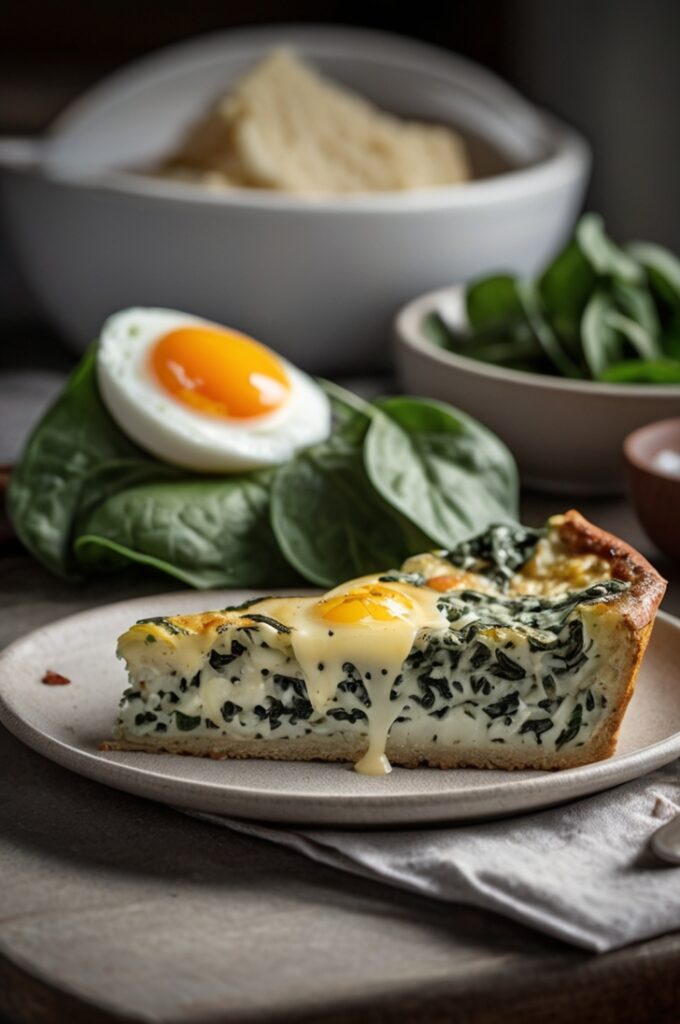Deliciously Fluffy Spinach Frittata Recipe that’s what this story is really about. A frittata that’s soft in the middle, golden at the edges, and filled with spinach that actually tastes like something. It’s not just eggs and greens in a pan. It’s restraint. It’s timing. It’s knowing when to stop stirring and just trust the heat.
And that’s why this fluffy spinach frittata matters. It’s not just brunch it’s how you show restraint and control. You learn when to stop stirring, when to drop the heat, and when to just back off and let the oven do its thing. It’s eggs, yeah. But it’s eggs with discipline.
What makes this spinach frittata special? Texture. Lift. Balance. It’s not rubbery, not weepy, not bland. It’s light but satisfying. Packed with flavor but never loud. The spinach melts in, the cheese wraps around it, and the eggs puff like a soufflé that forgot to be insecure.
You get technique without the fuss. Layers of flavor. Ingredients that do their job and don’t show off. This is how you make a spinach frittata that actually feels like food and not an afterthought.
Ingredients & Substitutions

Let’s be clear ingredients matter. No cheating with soggy frozen spinach unless you’re wringing it out like your life depends on it.
- 6 large eggs – Room temp, always. Cold eggs make everything take longer and cook unevenly.
- 1/2 cup heavy cream – Or full-fat milk if you’re watching calories (but why?).
- 2 tbsp olive oil – Use a grassy, peppery extra virgin one. It should taste like something.
- 1 small yellow onion, finely diced – Shallots work if you want a gentler sweetness.
- 2 garlic cloves, minced – Don’t skip this. It’s not optional. Unless you like boring.
- 3 packed cups fresh spinach – Rough chopped. Baby spinach is delicate. Mature spinach brings more iron-y heft.
- 1/2 cup grated Gruyère or aged cheddar – Nutty Gruyère melts like a dream. Cheddar gives punch. Don’t use pre-shredded unless you hate yourself.
- Salt and pepper – To taste. Which means you taste it, don’t guess.
- Pinch of nutmeg (optional) – It’s classic with spinach and eggs. But subtle. Just a whisper.
Subs and swaps:
- Dairy-free? Use unsweetened oat milk and skip cheese or add dairy-free cheddar.
- Low-fat? Use half-and-half. Just don’t tell me about it.
- Spinach swap? Try Swiss chard (remove stems) or sautéed kale if you’re feeling fibrous.
Tip: Fresh herbs like parsley, dill, or chervil tossed in at the end will freshen things up. Dried herbs? Only if they still smell alive when you open the jar.
Step-by-Step Instructions
A good frittata starts on the stove and ends in the oven. Skip one and you’ll regret it.
1. Preheat the oven to 375°F (190°C).
This isn’t a quiche. We’re not doing a low, slow bake. We want lift.
2. Sauté the onions in olive oil over medium heat.
Use a 10-inch oven-safe nonstick or well-seasoned cast iron pan. Stir till translucent, not browned. If they crisp, you lose the sweetness.
3. Add garlic. Cook 30 seconds.
Don’t walk away. Garlic burns fast and bitter is forever.
4. Toss in the spinach. Stir until wilted, about 2 minutes.
Do not overcook. You want it tender, not mushy. Season lightly.
5. In a bowl, whisk eggs, cream, salt, pepper, and nutmeg.
Vigorously. You want air in there. Not foam, but fluff.
6. Pour the egg mixture into the pan over the spinach.
Don’t stir it. Just tilt the pan to distribute. Let it cook on the stovetop for 2-3 minutes until the edges just set.
7. Sprinkle cheese over the top.
Even distribution, don’t clump. This ain’t lasagna.
8. Transfer to the oven. Bake 10–14 minutes.
Watch for a gently puffed center that barely jiggles when nudged. Overbaking is the death of fluff.
9. Let rest 5 minutes before slicing.
Yes, it’s hot. Yes, you’re hungry. Still, wait. The steam needs to settle or you’ll end up with scrambled soup.
Pro Tip: Use a small offset spatula to loosen the edges before slicing. Looks clean, no tearing.
Common mistake? People forget to season the eggs. The inside ends up tasting like boiled air. Fix that early. Taste the mixture raw (yes, raw) if you dare.
Cooking Techniques & Science
This isn’t a freestyle scramble. You need structure.
Why pre-cook the spinach?
Raw greens release too much water. That means a soggy, dense frittata. Wilt it first, evaporate the liquid. That’s how you get lift.
Egg-to-cream ratio matters.
Too much cream, it’s a custard. Too little, it’s rubber. About 1 tablespoon per egg is a sweet spot for fluff and richness.
Why oven-finish?
The stovetop gives you that bottom crust. The oven gives you even rise without burning the base. Trying to cook it entirely on the stove? Prepare for heartbreak.
Tool talk:
- Cast iron = crusty edges and heat retention.
- Nonstick = ease and soft texture.
- Metal whisk = better aeration than a fork.
- Microplane = nutmeg perfection. Don’t use the big grater unless you want surprise mouth-shards.
There’s no baking powder here. The puff comes from trapped air. So whisk like you mean it.
Serving & Pairing Suggestions
Slice into wedges. Serve warm or room temp. It’s not picky.
Garnish ideas:
- A handful of microgreens with lemon vinaigrette
- Shaved Parmesan and cracked black pepper
- A spoonful of crème fraîche with a pinch of smoked paprika
Good sides:
- Bitter greens salad with a sharp vinaigrette
- Roasted baby potatoes with rosemary
- Crusty sourdough. Toasted. Buttered. Nothing fancy.
Drinks?
- Dry sparkling wine if it’s brunch.
- Strong coffee with a dash of cardamom.
- For a non-boozy route, cold hibiscus tea hits that tart note.
Why This Frittata Works

Because it’s not trying too hard.
You get that custardy interior. Spinach that doesn’t taste like cafeteria sadness. Cheese that feels like a feature, not an afterthought. And enough structure to stand alone without needing crust or frills.
The eggs are bar
ely set. The top is just golden. You cut in, and there’s lift. Not a spongy mess. Not something that looks like it came from a plastic hotel tray.
Just real food. With intention.
FAQs About Deliciously Fluffy Spinach Frittata Recipe
1. Can I make a spinach frittata ahead of time?
Yes, but it’s best within a few hours. You can store it in the fridge, tightly covered, and reheat gently in the oven. Avoid the microwave it wrecks the texture.
2. Can I freeze frittata?
Technically yes, but don’t. It turns spongy and weeps moisture. Eat fresh or keep in the fridge up to 3 days max.
3. How do I keep it from sticking to the pan?
Use plenty of oil, a nonstick skillet, or well-seasoned cast iron. Also, let it set before moving it. Rushing is the enemy.
4. Can I use frozen spinach?
Sure. Just thaw completely and squeeze out every last drop of water. Seriously squeeze it like you mean it.
5. What’s the best cheese for frittata?
Gruyère is a pro move. Fontina, Manchego, even feta if you want tang. Just avoid overly moist cheeses like fresh mozzarella unless you dry it first.
This spinach frittata isn’t fancy. But it’s full of lessons. About heat, patience, and balance. About not overworking your eggs or under-seasoning your greens.
It’s the kind of thing you make when you want to cook something honest.
And you don’t need a million ingredients. You just need to mean it.
Final Expert Tips
- Always cook in a preheated pan. Cold pans = tough bottoms.
- Salt early, and salt again. Undersalted eggs are irredeemable.
- Don’t overcrowd with fillings. Keep it simple. You’re not making egg salad with decorations.
- Want an even lighter texture? Separate the eggs. Whip whites to soft peaks. Fold back in. But that’s next-level.
For a deeper flavor profile, add caramelized leeks instead of onions. Or crumble a bit of cooked pancetta into the mix. Just don’t go overboard. Keep it elegant.




